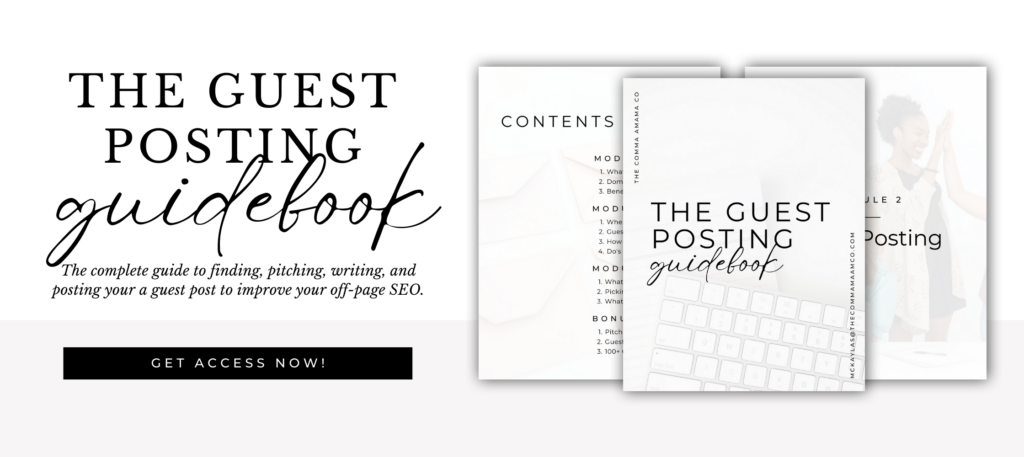I have a love for words and a knack for SEO – and as a mama, I know just how challenging it can be to run a business while raising a family. This blog is just one of the many resources you’ll find here that’ll help you boost your online visibility without sacrificing your sanity.
Thanks for being here (and I hope you’ll stick around).
Mckayla
categories
blogging
seo
Business
free seo checklist
get your checklist
explore
case studies
to the shop
work with us
follow us on instagram
share
Get access to six simple things you can do in 15-minutes or less to improve your SEO and get your website (and content) to show up in search.
You’re working on your off-page SEO, but you’re hearing a lot of terms you’re not that familiar with – two of which being do-follow and no-follow backlinks. While you may be familiar with the term “backlink” (a link from one website to another), do-follow and no-follow are new to you. So, what’s the difference between do-follow and no-follow backlinks and why does it matter?
Backlinks play a huge role in off-page SEO, and categorizing backlinks by their placement and type allows us to analyze how much a backlink can or will affect your SEO. For example, the domain authority of the website backlinking or whether the backlink is a do-follow or no-follow.
While, ultimately, the type of backlink will be made by Google bots, the preference can be set by the website owner.
Let’s look at the difference between do-follow and no-follow backlinks and how it can affect your SEO:
What Are Do-Follow Backlinks?

Dofollow backlinks are backlinks that link from one website to another that are marked as a link that can be crawled. Crawled do-follow backlinks typically result in an improvement in the linked website’s SEO.
When you earn a do-follow backlink, the website that is backlinking to your website is essentially vouching for your content – it’s telling Google crawlers that your content is valuable and should be shown to users.
Do-follow links are key to a successful off-page SEO campaign and are extremely valuable when improving your domain authority.
What Are No-Follow Backlinks?
Essentially the complete opposite of do-follow backlinks, nofollow backlinks are backlinks linking from one website to another that are marked as “do not follow” by the website.
Technically, crawlers will still visit the webpage, but rather than vouching for them and giving their SEO a boost, it’s more of just a mention. Now, if Google finds the link valuable, they will change it to a do-follow link themselves.
No-follow links are used when websites want to mention another webpage, but don’t want to vouch for them. For example, a sponsored post or paid links are marked as no-follow.
Backlinks from social media websites such as Instagram, Facebook, Twitter, LinkedIn, and Pinterest are typically no-follow links. Some exceptions are made, for instance, Pinterest’s top pins and round-ups earn you a do-follow link from Pinterest!
How Do Do-Follow and No-Follow Backlinks Affect Your SEO?

Backlinks are an important aspect of off-page SEO, one of the three main aspects of SEO. Still, not all backlinks are treated equally. This is where one of the biggest differences between nofollow and dofollow backlinks appear.
Dofollow backlinks can drastically improve your SEO with just a few from high-DA websites. Nofollow backlinks take time, and although they can generate more traffic to your website, they still do not have near as much impact on your SEO.
Both types of backlinks can be acquired passively over time but may depend on your content – for instance, if you have a blog, you’re more likely to acquire passive dofollow backlinks as other websites have more reason to link back to a resource on your site.
In fact, businesses that blog get 97% more backlinks to their website.
How Do You Actively Acquire Backlinks to Improve Your SEO?
Both do-follow and nofollow backlinks can be actively acquired – although you should NEVER buy backlinks. NEVER. This is a terrible practice that can severely hurt your SEO, it’s like buying followers on Instagram.
The best way to acquire nofollow backlinks is to be active online. This means setting up and sharing your content on social media, forums, etc. This should also feel natural. Backlinks gathered this way should not be spammed aka don’t drop your link just for the hell of it.
Acquiring do-follow backlinks is simple, but requires a little extra effort for the extra payoff. Do-follow links can be acquired by:
- Joining high-quality online directories
- Pitching direct link placement (not paid) to relevant websites
- Guest posting for websites in your niche
Other ways you can acquire do-follow backlinks can include being a podcast guest (depending on where their podcast is hosted), performing well on Pinterest, and PR from news or other similar websites.
How Do You Passively Acquire Backlinks for SEO?

The best method of generating both types of backlinks passively is by creating high-quality content that serves your audience. When you create content that others find valuable, they want to backlink to it in their content.
High-quality content written for SEO also performs well in search and will appear as other writers/bloggers/business owners are looking for references to use for their content.
While the writing of a blog post is timely, considering the planning, research, writing, and publishing can take between 2 to 8 hours depending on the length of a blog post, it doesn’t seem as time-effective for backlinks. BUT, a blog post has a lifetime of 2+ years when ranking, meaning that 2-8 hours of work can pay off for years to come.
If you’re looking to improve your off-page SEO right now, I recommend looking into our Guest Posting Guidebook (for blogging beginners) or our Guest Post Directory (for blog pros looking for more opportunities).
Looking for a more passive way to generate backlinks? Book your quarterly content today! You get 12-36 blog posts planned, researched, and published for you over the course of three months -> Apply today!

Reader Etiquette
© - Content and images in this blog are copyright this blog unless stated otherwise. Feel free to repost or share images for non-commercial purpose, but please make sure to link back to this website and its original post.
℗ - We do not store any information about your visit to our website other than for analytics and optimization for content and reading experience through the use of cookies.
c/o - Our site does at times contain paid advertisements, sponsored content, and/or affiliate links.
You might want to check these out too while you're at it
categories
blogging
SEO
business
It's me, hi! Your SEO bestie.
get to know me
work with us
//
services
//
case studies
//
Mom of three, lover of all things blogging, and borderline obsessive coffee drinker — I also just happen to love making complicated things simple and accessible, especially when it comes to SEO. The blog is a collection of what I've learned from years of testing, trial and error, and working with amazing clients with impactful businesses (just like yours). Blogging and SEO doesn't have to be boring — and it definitely doesn't need to be difficult.
Mckayla
get your checklist
Want to improve your website SEO in one afternoon? This free resource offers 6 actionable steps you can take in 15 minutes or less to instantly improve your SEO.



